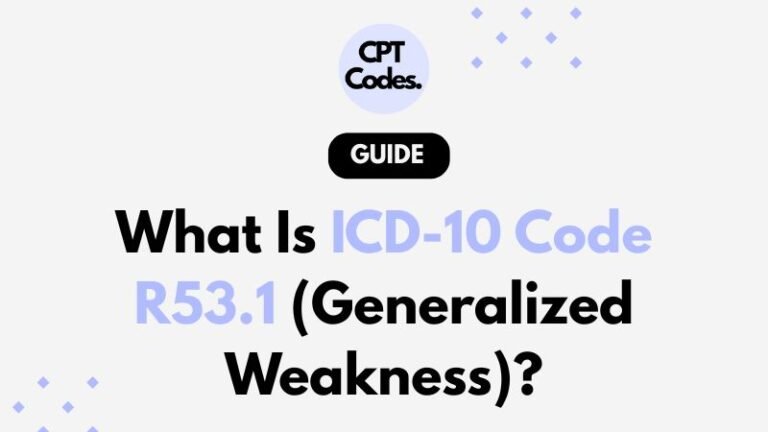The ICD-10 code R53.1 is used to capture generalized weakness, a diffuse loss of strength that is not limited to a specific limb or muscle group. It is a symptom code rather than a diagnosis. You use R53.1 when a patient presents with weakness and no specific underlying diagnosis has been confirmed. Proper use of this code depends on careful documentation to support the symptom and avoid coding errors.
Understanding Generalized Weakness in Clinical Practice
In everyday clinical settings, patients sometimes describe a pervasive sense of weakness. This is different from localized weakness (for example, a weakness in one arm). Because generalized weakness affects multiple parts of the body, it often signals a broader underlying issue.
Common Causes of Generalized Weakness
Generalized weakness is a nonspecific symptom. Some frequent causes or contributing factors include:
- Infectious diseases such as sepsis, influenza, or pneumonia
- Endocrine disorders (for instance, hypothyroidism, adrenal insufficiency, or poorly controlled diabetes)
- Neurological conditions (like multiple sclerosis, myasthenia gravis, or stroke)
- Chronic illnesses (renal disease, chronic liver disease, or heart failure)
- Side effects of medications (for example, sedatives, chemotherapy agents, or some antihypertensives)
Because of its broad differential diagnosis, generalized weakness should prompt a careful and methodical evaluation.
When and How to Use ICD-10 Code R53.1
When to Use It
- Use R53.1 when a patient’s chief complaint is generalized weakness and no definitive cause has been established yet.
- It can be a billable code, provided that the clinical documentation supports it.
- It may also be used temporarily until a more precise diagnosis is confirmed.
When Not to Use It (or When to Stop Using It)
- Once a specific underlying condition is diagnosed (for example, hypothyroidism or a neuromuscular disease), that more specific diagnosis should take priority in coding.
- At that point, R53.1 can still be included as a secondary or supporting code to reflect the symptom, but it should not be the principal diagnosis if the cause is known.
Codes Related to Weakness, Fatigue, and Malaise
It’s important to distinguish generalized weakness (R53.1) from other related symptoms, since ICD-10 offers several adjacent codes:
- R53.0 — Neoplastic (cancer-related) fatigue
- R53.2 — Functional quadriplegia
- R53.8 — Other malaise and fatigue
- R53.81 — Other malaise
- R53.82 — Chronic fatigue, unspecified
- R53.83 — Other fatigue
Accurate differentiation ensures that medical claims are clear and reduces the risk of coding or billing errors.
How to Document So That R53.1 Is Justified
Accurate documentation is essential to support the use of R53.1. Here are best practices:
-
Describe the Weakness Clearly
Indicate whether the weakness is generalized or localized. Note if it’s symmetrical, the extent of involvement, which parts of the body are affected, and if it’s worse in certain limbs. -
Note Onset, Duration, and Progression
Record when the weakness began, how long it has lasted, whether it’s worsening or fluctuating, and any patterns (e.g., worse in the morning). -
List Associated Symptoms
Include any accompanying symptoms, such as fatigue, dizziness, difficulties with daily living, muscle pain, weight changes, or neurological signs. -
Include Relevant Medical History
Mention chronic diseases, recent infections, metabolic or endocrine disorders, and medications (especially any known to cause muscle weakness). -
Update Documentation Over Time
As diagnostic results come in (lab work, imaging, neurology consults), update the record to reflect confirmed diagnoses and change coding accordingly.
Challenges and Common Pitfalls with R53.1
1. Continuing to Use R53.1 After Confirming a Diagnosis
If clinicians continue to rely on R53.1 even after a definitive diagnosis is identified, it can lead to improper coding and claim rejections. Always switch to the more precise diagnosis code when available.
2. Confusing Weakness With Fatigue or Malaise
Weakness is a reduction in strength. Fatigue is a sense of exhaustion or tiredness. Malaise is a vague feeling of discomfort or unease. If notes do not distinguish these clearly, coders may choose the wrong code.
3. Failing to Sequence Secondary Codes Properly
When a definitive diagnosis exists, the specific disease should be coded as primary, and R53.1 (if still relevant) as a secondary. Incorrect sequencing can undermine medical necessity claims.
4. Vague or Incomplete Documentation
If provider notes lack clarity on onset, severity, distribution, or relevant history, coders may lack support to assign R53.1. This can lead to denials or adjustments during billing reviews.
Tips to Avoid Errors in Using R53.1
- Always query the clinician if documentation is ambiguous or lacks detail.
- Review payer policies, as some payers may have stricter requirements for symptom codes.
- Periodically audit coded cases to ensure R53.1 was used appropriately and updated after diagnoses emerge.
- Train providers and coders to distinguish weakness, fatigue, and malaise in documentation and coding.
Summary
ICD-10 R53.1 is the designated code for generalized weakness, it captures a symptom rather than a full diagnosis. Use it when patients present with diffuse loss of strength and no underlying cause is yet identified. Strong documentation and careful updates are key to using it effectively. As investigations reveal a more specific condition, codes should be revised accordingly to reflect the true underlying diagnosis.

